Cholula – The World’s Largest Pyramid (Really!)
This morning on our continuing tour of Central Mexico with Adventures Abroad guide extraordinaire Victor Romagnoli we visited the amazing murals of Cacaxtla. This afternoon we are moving on to the nearby city of San Pedro Cholula where we will visit another astounding pre-Columbian sight, the Great Pyramid of Cholula which is the largest in the world by volume. Join us as I explore the pyramid and explain why hardly anybody’s even heard of it. Oh, and BTW, this is not where one of my favourite hot sauces is made. Cholula hot sauce with the distinct wooden cap actually comes from Jalisco state, on the Pacific coast west of here.
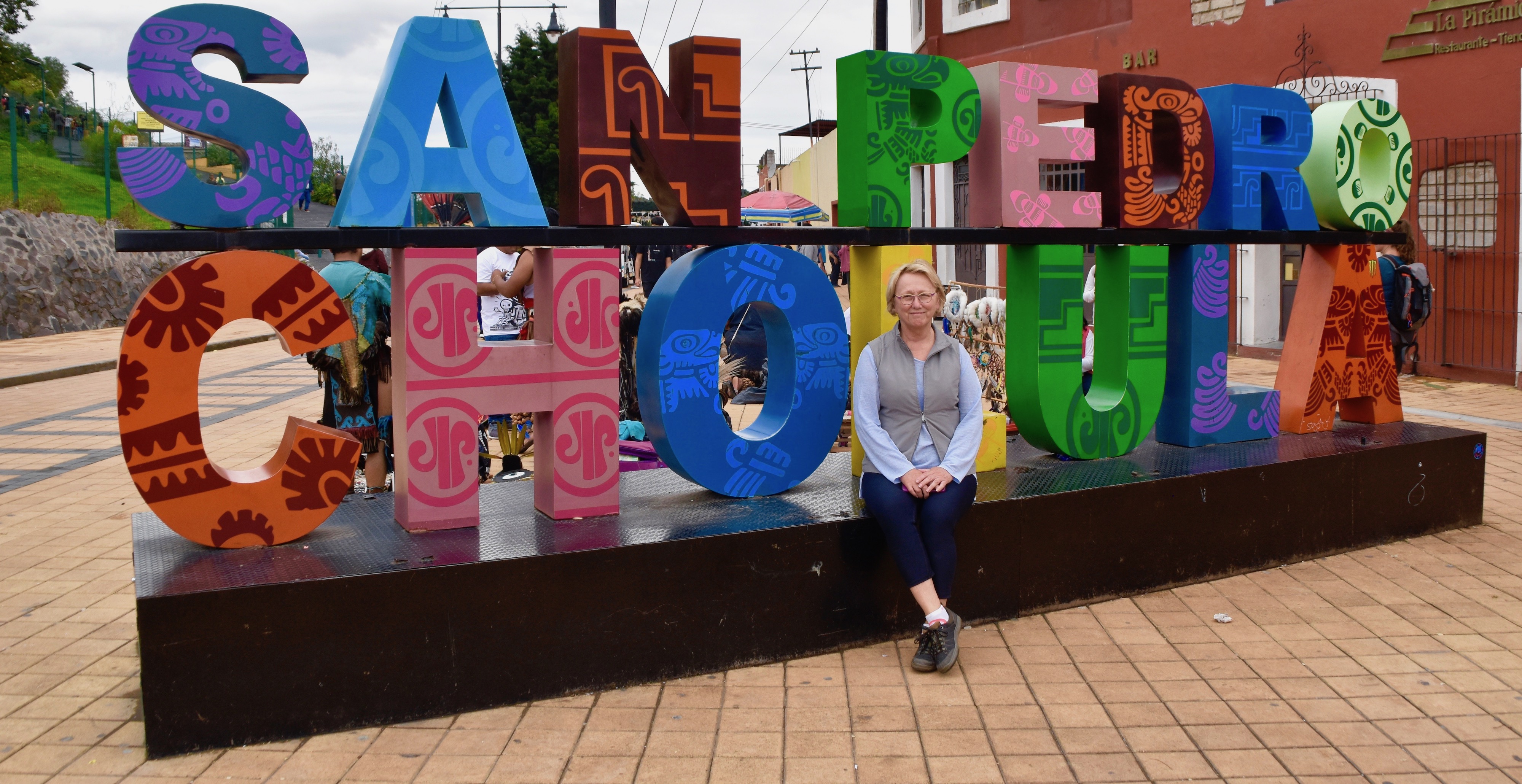
Cholula lies only a short distance outside the city of Puebla which has totally eclipsed the former in both size and economic importance. Modern day Cholula is actually divided into two municipalities, San Pedro in which Alison is sitting and San Andrés which starts right behind this sign and is where the Great Pyramid is located. Today the city has just under 200,000 residents. It wasn’t always this way. Long before Puebla was even a thought in anyone’s mind Cholula was already over a 1,000 years old and may have had a population as large as 100,000 at some point in its long history. It was still a going concern when Cortés arrived in 1519. Here’s what you need to know before visiting Cholula.
History of Cholula
Like many of Mexico’s great pre-Columbian cities the original builders of Cholula are shrouded in mystery. Everyone agrees that it has one of the best locations in Mexico due to very fertile soil, the reliability of the water supply and positioning between the coast at Veracruz and the high central plateau where Mexico City is located. In other words it was a natural place to build a settlement once the indigenous people transitioned from hunter gatherers to agriculturalists. Some think that may have happened as long ago as 500 B.C. which, if true, would make it the oldest continuously occupied city in the New World.
For certain there was a major settlement here by 200 B.C. and work on the Great Pyramid may have started as early as that. The problem with interpreting the building of the Great Pyramid from the archaeological remains is that it was built in ten identifiable stages, four of which were major. Unlike Egyptian pyramids that were built by one individual to serve as tombs and thus had to be built quickly, Meso-American pyramids could be built over a period of hundreds of years. We already saw earlier on this tour during a visit to the Templo Mayor of the former city of Tenochtitlan in the heart of Mexico City, that instead of starting from scratch, the builders would simply cover over the old pyramid with a new enlarged shell. This happened four times (other accounts say six) at the Great Pyramid which by the year 1000 had a base that was 450 metres (1476 feet) X 450 metres and was 66 metres (216 feet) high. That made for a total base that is three times as large as the Great Pyramid of Giza with a considerably larger volume as well. At the top once stood a temple with a set of stairs leading up to it.
Then around 1,200 a strange thing happened. Cholula was invaded and occupied by an alliance of the Toltecs and Chichimecs. This was about the same time that the Toltec capital of Tula was destroyed. However, instead of sacking the city the invaders stayed put, but they weren’t so big on pyramids. They actually started to cover it up and eventually succeeding in completely burying it to the point that it was now called Tlachihualtepetl which is Nahuatl for ‘man made mountain’.
Cortés arrived in 1519 on his way to the Aztec capital of Tenochtitlan with his allies the Tlaxcalan who hated the Aztecs who apparently now ruled Cholula. Cortés wanted to send a message to the Aztec king Moctezuma about the wisdom of defying him and did so by perpetrating one of the worst massacres in New World history, virtually wiping out the entire ruling class of Cholula along with thousands of others. He then proceeded to destroy all the temples in Cholula of which there were said to be hundreds, and replace them with Catholic churches. The Church of Our Lady of Remedies that now sits atop the Great Pyramid is one of the most recognizable in all of Mexico.
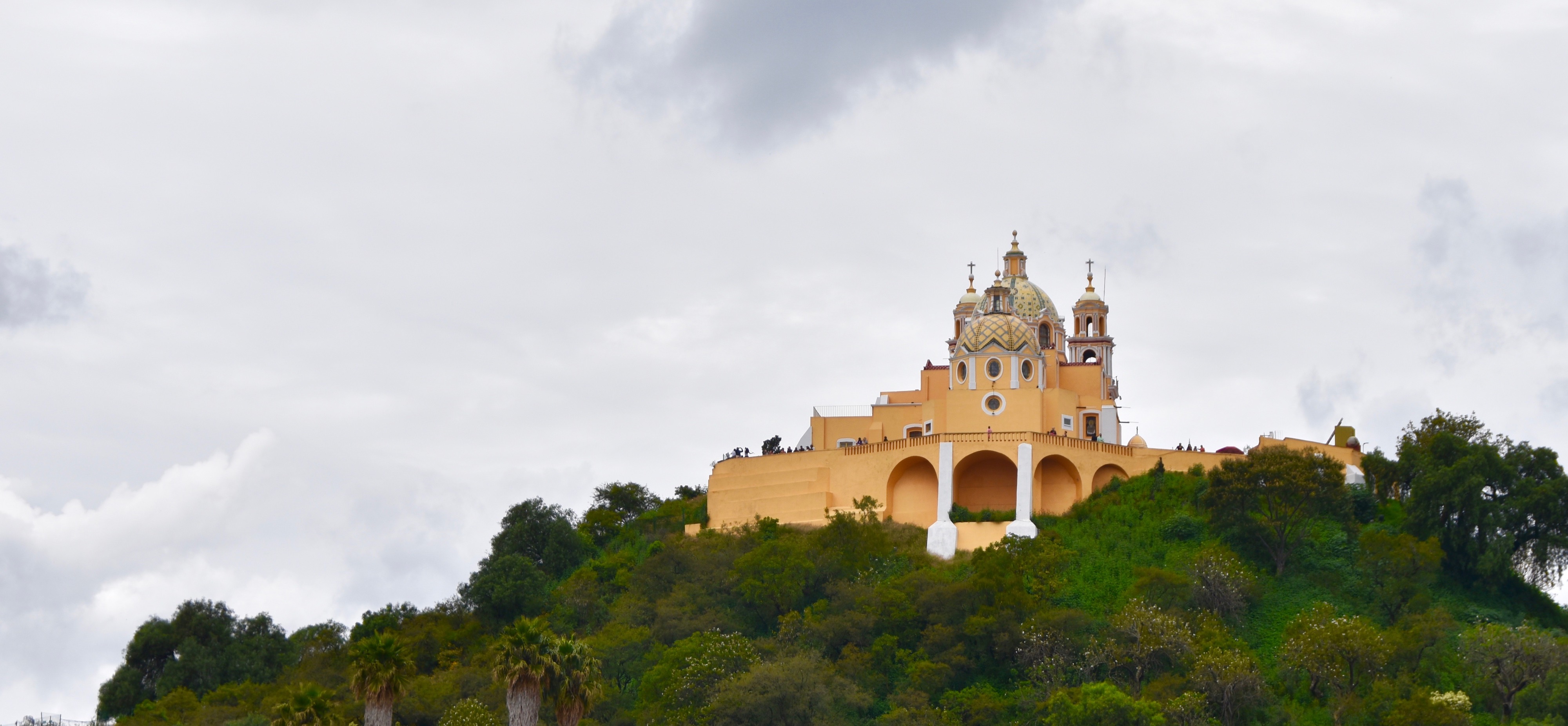
Our first stop in Cholula is at the small museum where our guide Jean-Luis provides many of the historical details I have set out above.

Inside there are models of how the Great Pyramid would have looked at its height before being buried although it certainly would not have been topped by a church, but rather a temple, probably to Quetzalcoatl.
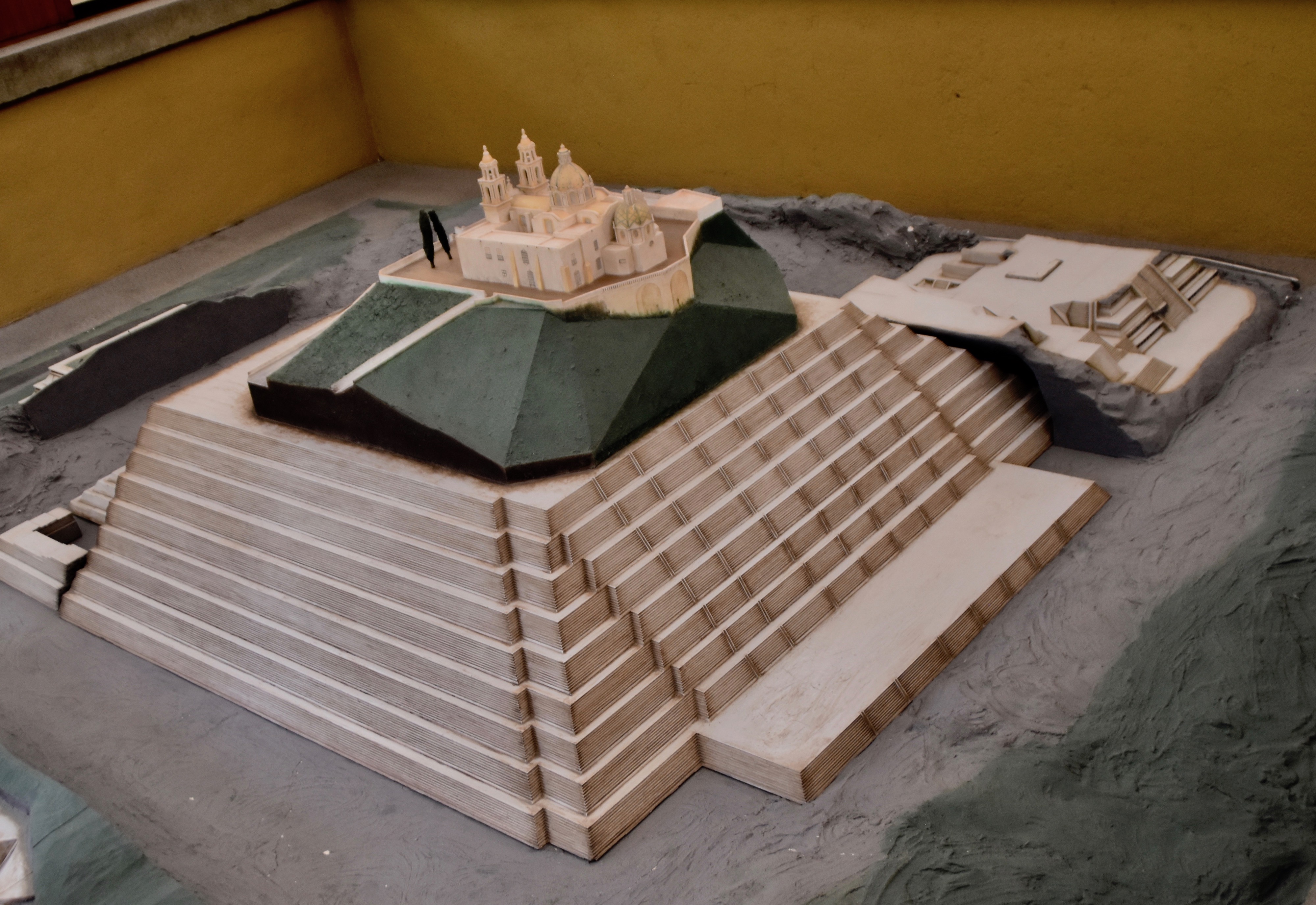
There is also a model of how the interior would have looked, somewhat like a set of Russian nesting dolls.
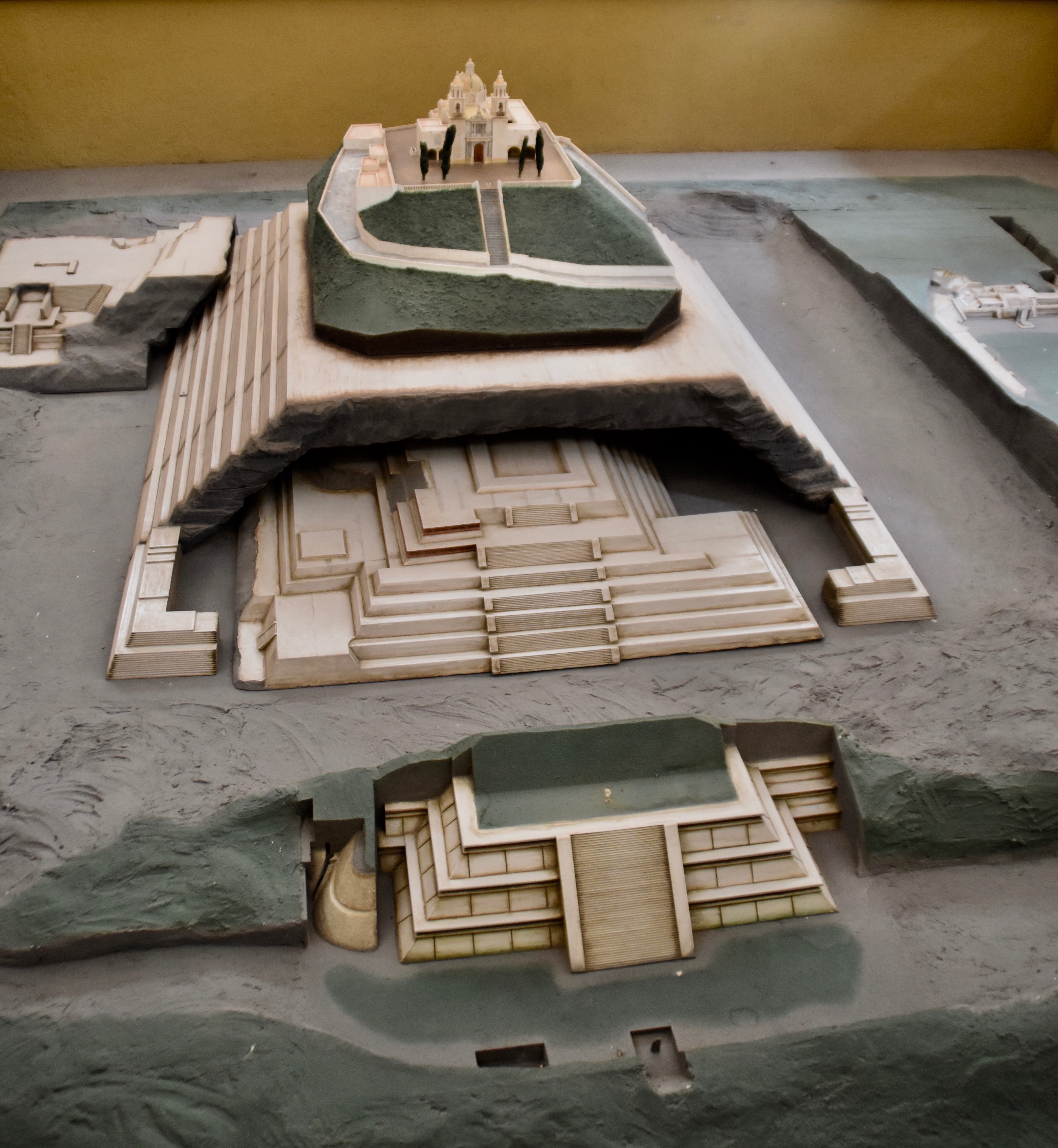
Beginning in the 1930’s archaeologists starting digging tunnels into the pyramid to find out what was inside with the result that today there are over eight kilometres (five miles) of tunnels, some of which are open to the public. That is how they were able to determine how many versions of the Great Pyramid there were and over what period of time it was constructed.
To me. the most interesting and horrifying exhibit in the museum was this contemporary drawing of a Spanish war dog attacking a helpless Aztec. Up until seeing this I had no idea that the Spaniards had bred and trained dogs specifically as weapons of war. Using mastiffs and wolf hounds that were starved before going into battle they were unleashed on the Aztecs who only knew dogs as a source of food. Now they were the ones who were the food as the starved dogs gorged on their entrails.
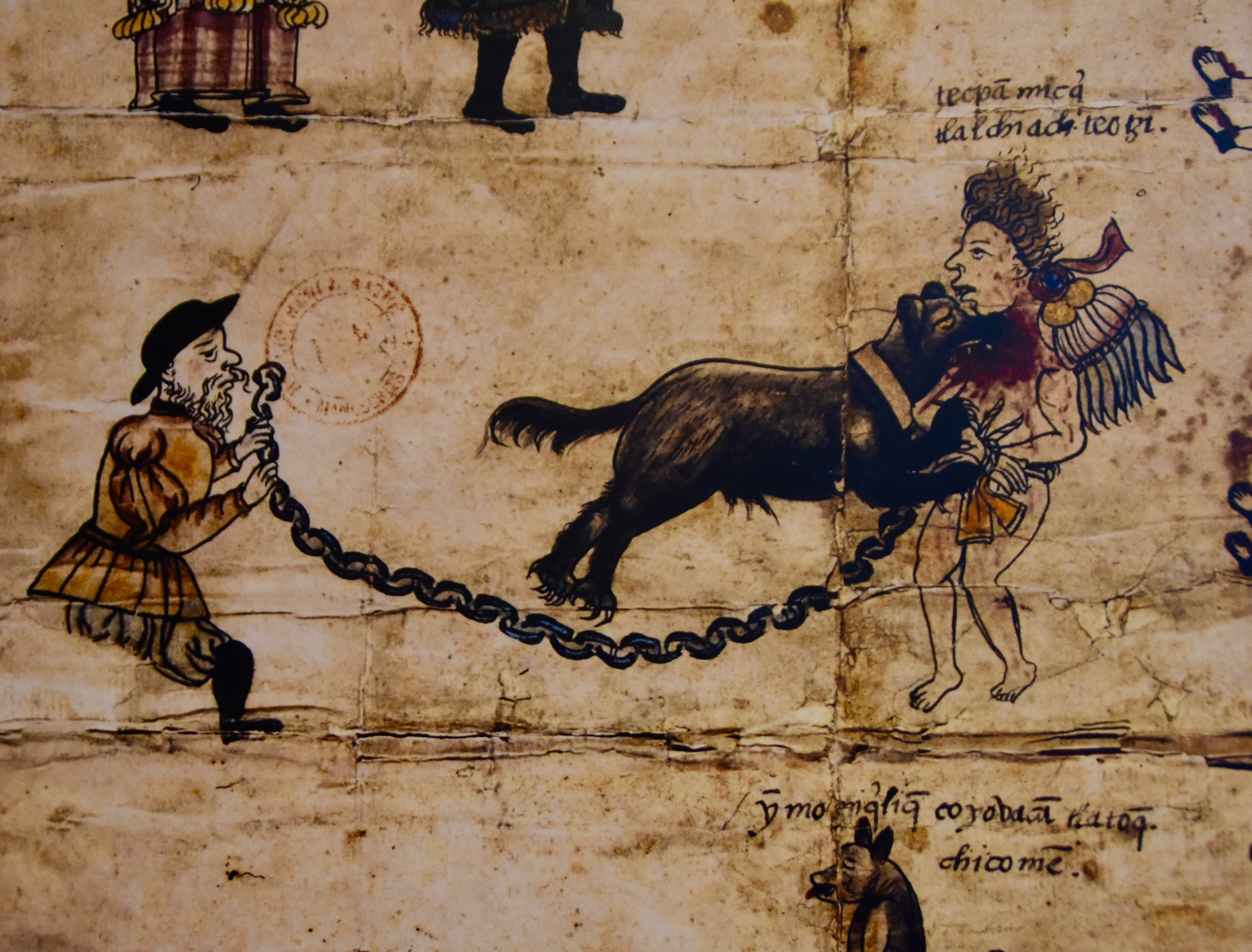
One of the great mysteries of history is how Cortés with only 490 men could have subdued a kingdom that could field an army of 200,000. Aside from the fact that he allied himself with the tribes that had been terrorized by the Aztecs for centuries, it was the use of weapons like war dogs and war horses that simply overawed the enemy. The terrorizers were now the terrorized. Some might call it poetic justice for a people who allegedly sacrificed 80,000 captives at the opening of the Great Pyramid of Tenochtitlan; I just call it another example of human barbarity.
On that happy note, we have a choice to make. We can either go underneath the Great Pyramid of Cholula by way of the tunnels or we can go up to the top, but we don’t have time to do both. Alison and I elect to forgo the tunnels and head for the stairs that lead up to Our Lady of the Remedies, forgetting for the moment that this is the equivalent of climbing the stairs to the top of a 21 story building.
We don’t forget for long as the climb up is steep and very taxing, especially in the thin air of Mexico’s central highlands.
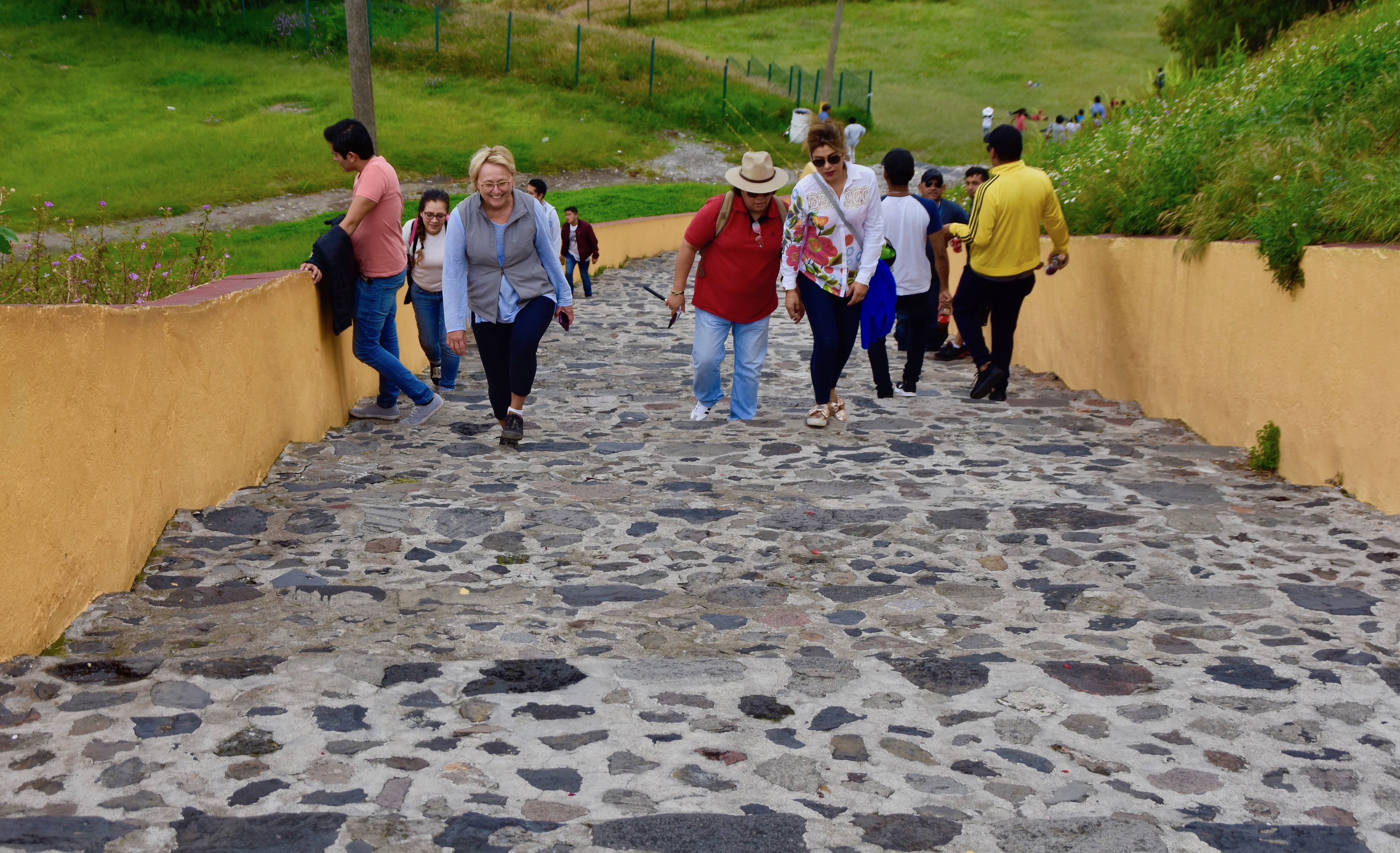
But boy is it ever worth it once you get to the top. There is a grand view in all directions and looking down you can see why Cholula is famed as The City of Churches, but as you can see from the photos it’s cloudy and the great volcanoes, Popocatépetl and Iztaccihuatl that you can ordinarily see from here are not visible today. Walking around the church in all directions and looking down you can get an idea of just how massive this pyramid is. In fact, it’s just too big to really get you head around that what you are standing on is entirely man made and without benefit of wheeled vehicles or horses and oxen.
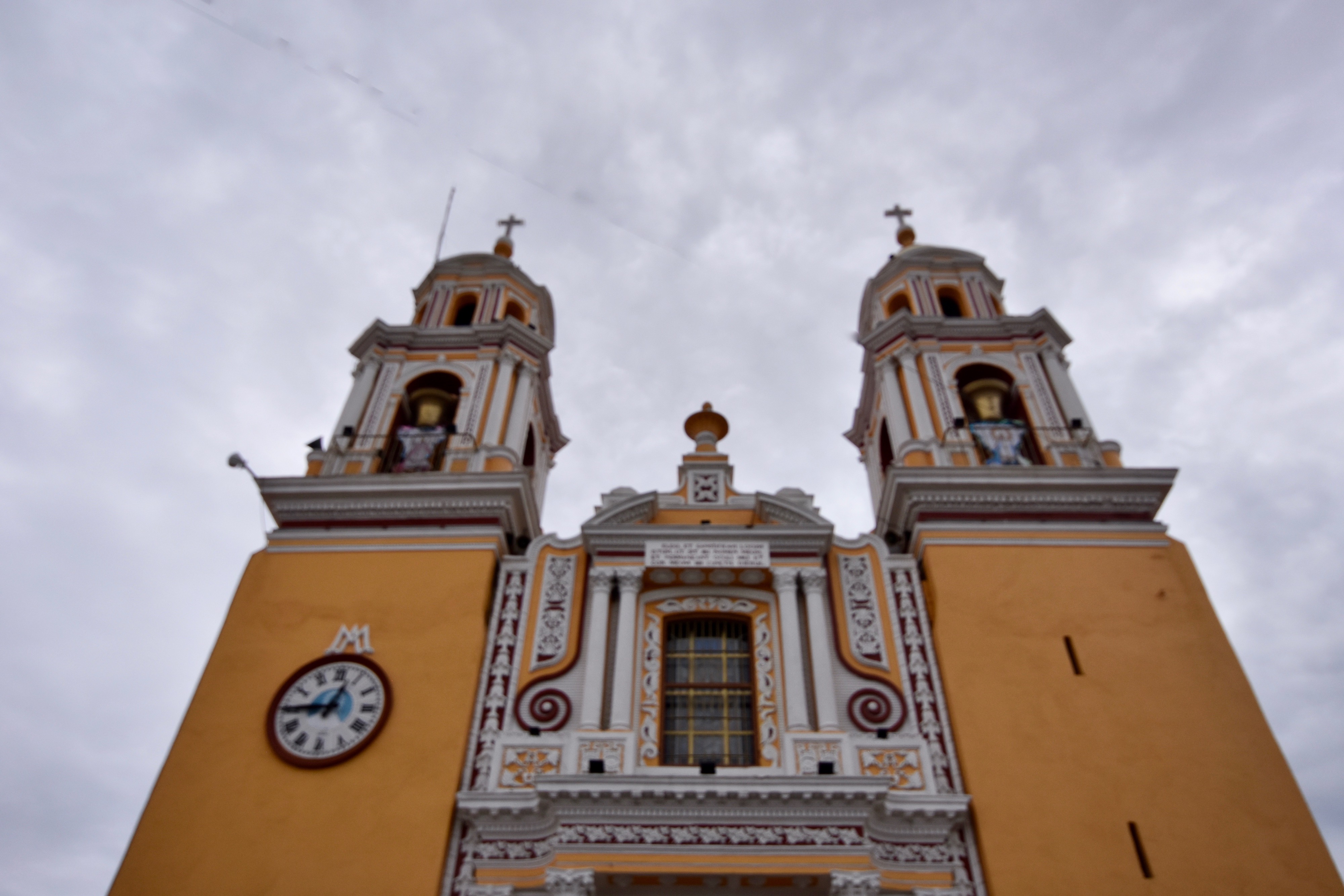
Iglesia de Nuestra Señora de los Remedios or Our Lady of the Remedies was built in 1574-5 and houses a statue of the Virgin Mary that was brought over by a member of Cortés crew in 1519 and may date as far back as 700 AD.
There was a ceremony taking place inside the church so we did not go in and after getting out breathing back to normal we headed back down to do a circle of the Great Pyramid.
It’s very difficult to get a photo that truly shows the size of the Great Pyramid. This was the closest I could get. The excavations at the bottom are the Courtyard of Altars where human sacrifice was practiced, most horribly of children, slaughtered to appease the rain god Tlaloc.
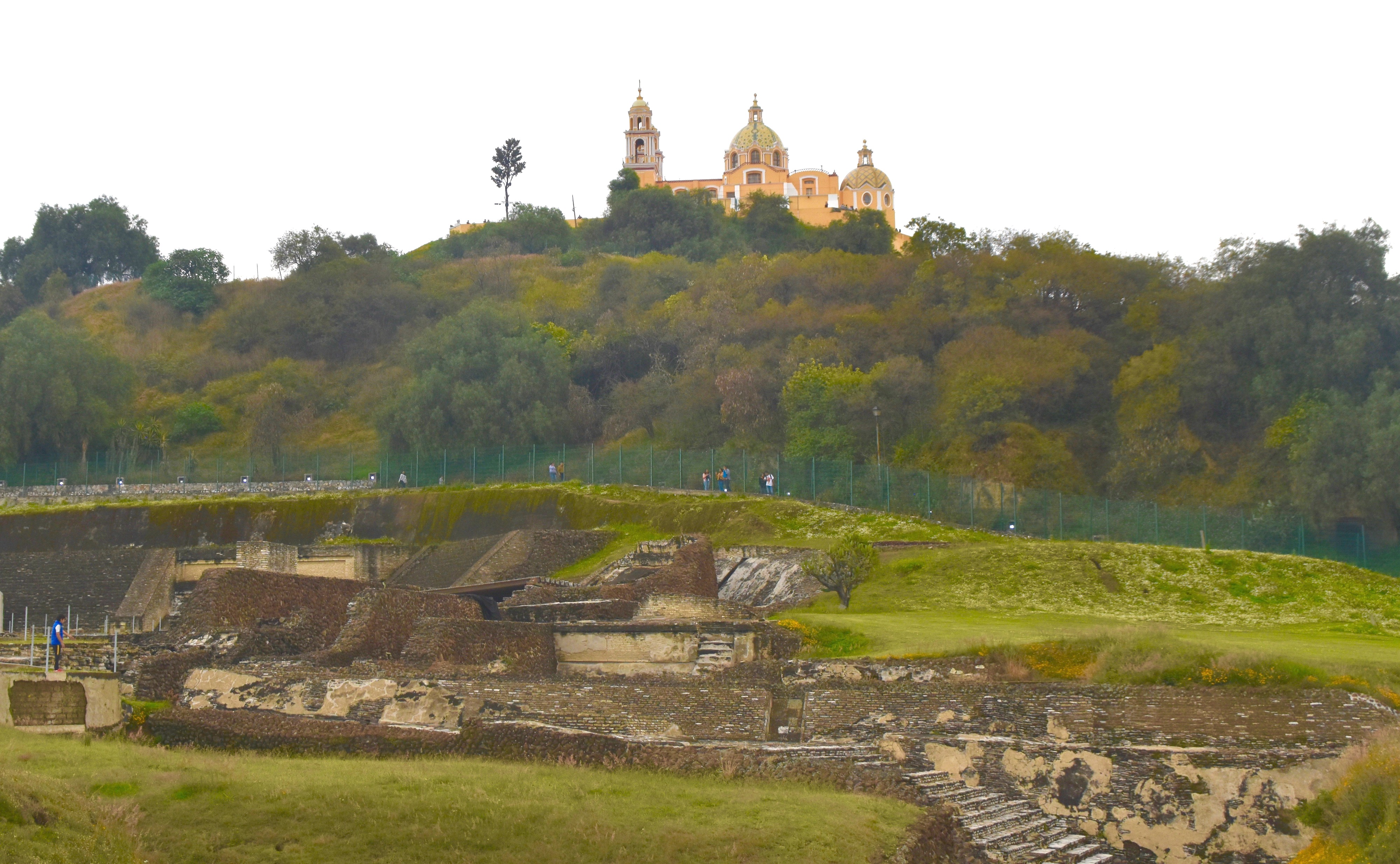
Also of great interest is the largest mural in pre-Columbian Mexico, Los Bebedores or the Mural of the Drinkers which depicts 164 individuals, essentially at a drinking party consuming pulque, made from the maguey plant, a type of agave and precursor of tequila and mezcal. Many of them are pissed to the gills and displaying and doing all the things that drunken dotards do. It’s 1800 years old and a contemporary of the much more well known Roman orgies of the same period. It has always been a mystery to me why the creation and consumption of alcoholic beverages which was common in pre-Columbian Meso-America, never made its way northward to the indigenous people of North America despite the fact that there was considerable trade over long distances in other products.
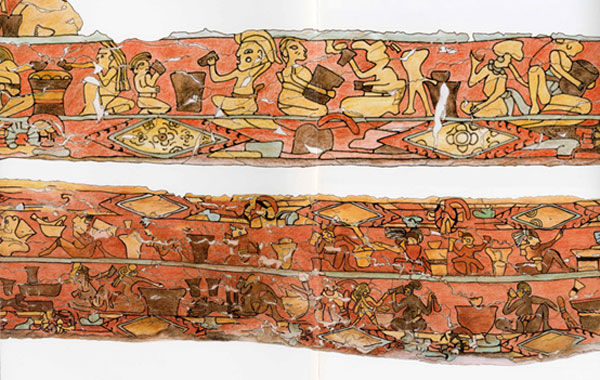
In the interests of full disclosure, I did not actually view Los Bebedores while in Cholula, but I am hoping that future trips might include this most interesting mural in the trip to the Great Pyramid. It was only discovered in 1969 and kept from public view until 2014. It is now on display only at very limited intervals so I certainly don’t fault Adventures Abroad for not including it on the itinerary. As far as I can tell it wasn’t open to the public when we visited Cholula, but you can always hope.
Coming full circle around the Great Pyramid you come to this impressive set of steps. The only problem is that this is a fake set of ruins, constructed in haste by one the archaeological teams to prove that they were getting results. In reality, the real results were coming mostly from the tunnels being excavated within the pyramid, but these were not flashy enough for the authorities so they had to be deceived in order keep the funding coming in.
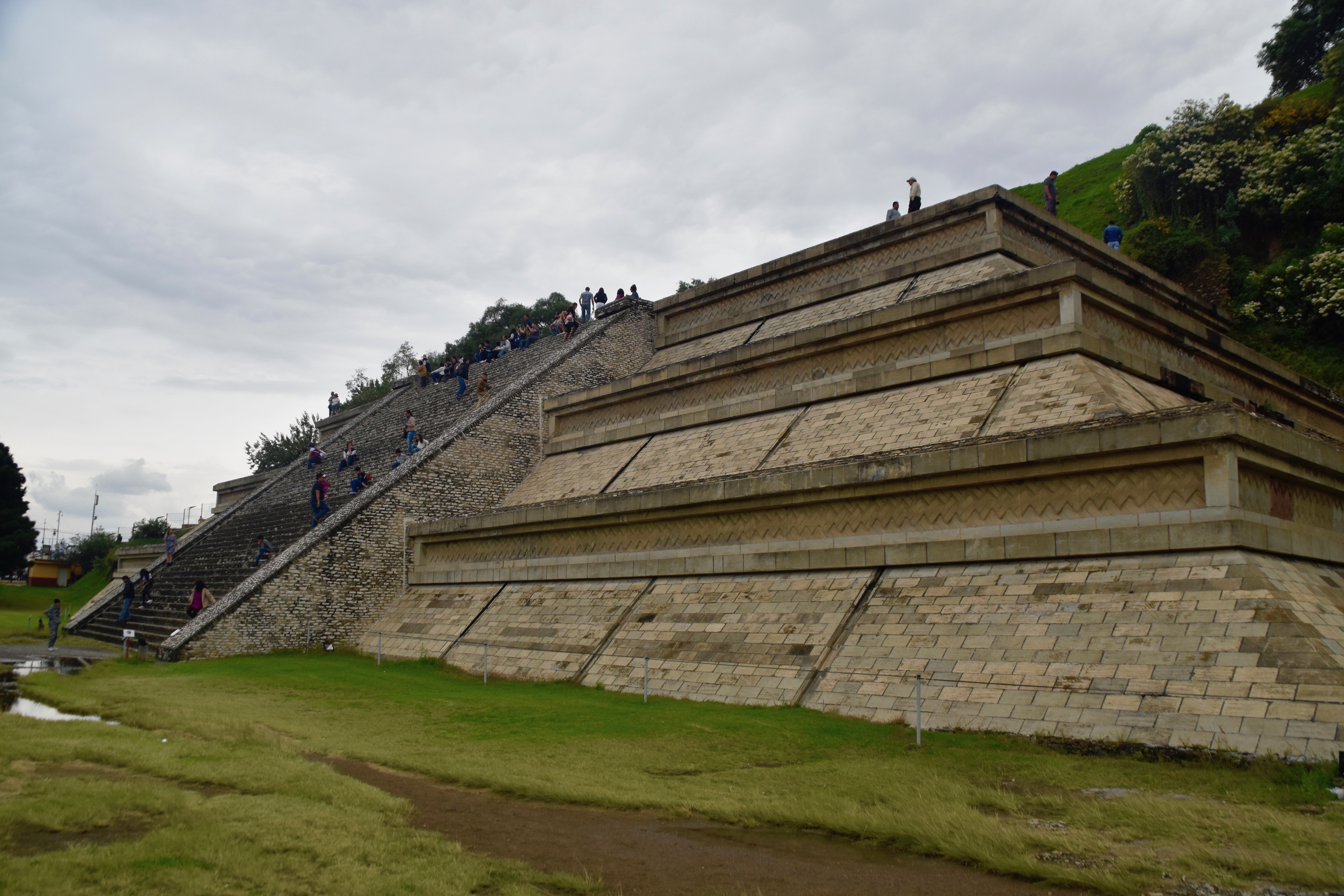
Even though it is the largest pyramid in the world by volume and by anyone’s standards a simply incredible accomplishment, the Great Pyramid of Cholula receives only a fraction of the visitors that other more visible Mexican pyramids do. It literally puts the truth into the saying “Out of sight, out of mind.” That’s too bad because Cholula is a great place to visit and if you are luckier than our group you’ll get to see this great scene that Mexico uses on much of its tourism promotion material.
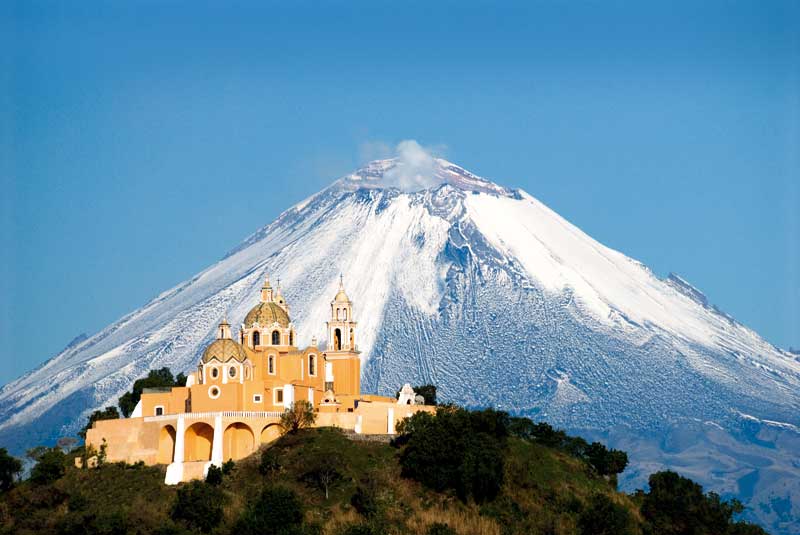
Next we will visit a great pyramid you can see and climb at the fabled city of Teotihuacan. See you there.

